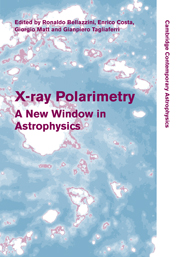Book contents
- Frontmatter
- Contents
- List of contributors
- Preface
- 1 X-ray polarimetry: historical remarks and other considerations
- Part I Polarimetry techniques
- Part II Polarized emission in X-ray sources
- Part III Future missions
- 37 Gravity and Extreme Magnetism SMEX (GEMS)
- 38 Programs of X-ray polarimetry in Italy
- 39 A polarimeter for IXO
- 40 Polarimetry with ASTRO-H soft gamma-ray detector
- 41 The Energetic X-ray Imaging Survey Telescope and its polarization sensitivity
- 42 PoGOLite: a balloon-borne soft gamma-ray polarimeter
- 43 Studies of neutron background rejection in the PoGOLite polarimeter
- 44 Observing polarized X-rays with PoGOLite
- 45 Pre-flight qualification tests of the PoGOLite detector system
- 46 The Gamma-RAy Polarimeter Experiment (GRAPE) balloon payload
- 47 POLAR: an instrument dedicated to GRB polarization measurement
- 48 Polarization detection capability of GRIPS
- 49 X-ray and γ-ray polarimetry small-satellite mission PolariS
- 50 GAP aboard the solar-powered sail mission
- 51 Hard X-ray polarimeter for small-satellite missions
- 52 Performance of hard X-ray polarimeter: PHENEX
- 53 GRB polarimetry with POET
- Author index
- Subject index
49 - X-ray and γ-ray polarimetry small-satellite mission PolariS
from Part III - Future missions
Published online by Cambridge University Press: 06 July 2010
- Frontmatter
- Contents
- List of contributors
- Preface
- 1 X-ray polarimetry: historical remarks and other considerations
- Part I Polarimetry techniques
- Part II Polarized emission in X-ray sources
- Part III Future missions
- 37 Gravity and Extreme Magnetism SMEX (GEMS)
- 38 Programs of X-ray polarimetry in Italy
- 39 A polarimeter for IXO
- 40 Polarimetry with ASTRO-H soft gamma-ray detector
- 41 The Energetic X-ray Imaging Survey Telescope and its polarization sensitivity
- 42 PoGOLite: a balloon-borne soft gamma-ray polarimeter
- 43 Studies of neutron background rejection in the PoGOLite polarimeter
- 44 Observing polarized X-rays with PoGOLite
- 45 Pre-flight qualification tests of the PoGOLite detector system
- 46 The Gamma-RAy Polarimeter Experiment (GRAPE) balloon payload
- 47 POLAR: an instrument dedicated to GRB polarization measurement
- 48 Polarization detection capability of GRIPS
- 49 X-ray and γ-ray polarimetry small-satellite mission PolariS
- 50 GAP aboard the solar-powered sail mission
- 51 Hard X-ray polarimeter for small-satellite missions
- 52 Performance of hard X-ray polarimeter: PHENEX
- 53 GRB polarimetry with POET
- Author index
- Subject index
Summary
PolariS (Polarimetry Satellite) is a Japanese small-satellite mission dedicated to polarimetry of X-ray and γ-ray sources. We aim to perform wide-band X-ray (2–80 keV) polarimetry of sources brighter than 10 mCrab, employing three hard X-ray mirrors and two types of polarimeters. X-ray and γ-ray polarimetry of transient sources with wide-field polarimeters is the second purpose. Most of the components have their prototype used or planned to be used in balloon and other satellite missions. Conceptual design is in progress for target launch in the mid 2010s.
PolariS concept
PolariS (Polarimetry Satellite) is a Japanese small satellite mission dedicated for polarimetry of X-ray and γ-ray sources. Design of the PolariS is now being discussed by the PolariS working group, which consists of 34 members from 11 institutes mainly in Japan, though informal international collaboration is under way.
The main purpose of the PolariS mission is wide-band X-ray (2–80 keV) polarimetry of sources brighter than 10 mCrab. We expect X-ray polarimetry with small satellites to be realized within several years. When measuring X-ray polarization of various type of sources, we consider the energy dependence of the polarization (degree and direction) to be essential to study the geometry and emission mechanisms of different objects, as has been pointed out by theoretical calculation. Furthermore, the hard X-ray band above 10 keV is of particular importance, since the physics we are exploring with polarimetry is in most cases nonthermal.
- Type
- Chapter
- Information
- X-ray PolarimetryA New Window in Astrophysics, pp. 333 - 338Publisher: Cambridge University PressPrint publication year: 2010
- 1
- Cited by



